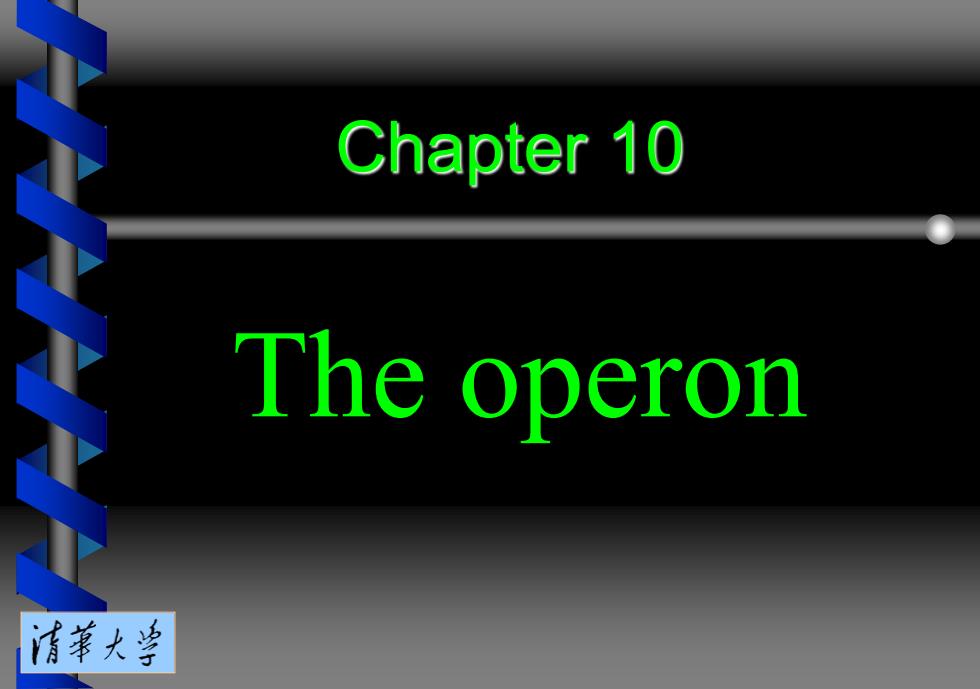
Chapter 10 The operon 清革大当
Chapter 10 The operon
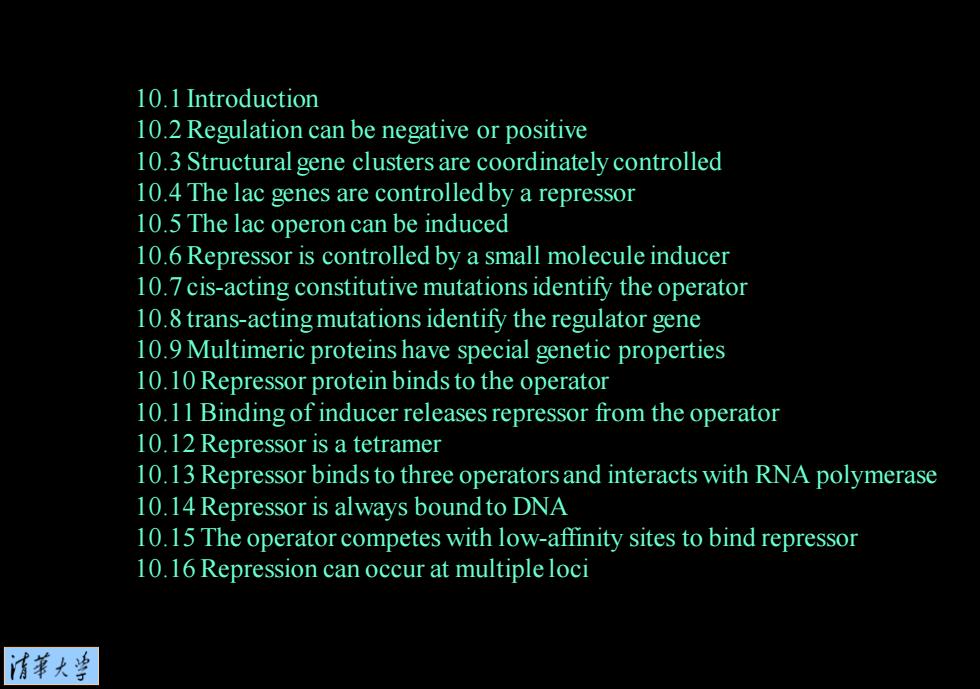
10.1 Introduction 10.2 Regulation can be negative or positive 10.3 Structural gene clusters are coordinately controlled 10.4 The lac genes are controlled by a repressor 10.5 The lac operon can be induced 10.6 Repressor is controlled by a small molecule inducer 10.7 cis-acting constitutive mutations identify the operator 10.8 trans-acting mutations identify the regulator gene 10.9 Multimeric proteins have special genetic properties 10.10 Repressor protein binds to the operator 10.11 Binding of inducer releases repressor from the operator 10.12 Repressor is a tetramer 10.13 Repressor binds to three operators and interacts with RNA polymerase 10.14 Repressor is always bound to DNA 10.15 The operator competes with low-affinity sites to bind repressor 10.16 Repression can occur at multiple loci 情莘大当
10.1 Introduction 10.2 Regulation can be negative or positive 10.3 Structural gene clusters are coordinately controlled 10.4 The lac genes are controlled by a repressor 10.5 The lac operon can be induced 10.6 Repressor is controlled by a small molecule inducer 10.7 cis-acting constitutive mutations identify the operator 10.8 trans-acting mutations identify the regulator gene 10.9 Multimeric proteins have special genetic properties 10.10 Repressor protein binds to the operator 10.11 Binding of inducer releases repressor from the operator 10.12 Repressor is a tetramer 10.13 Repressor binds to three operators and interacts with RNA polymerase 10.14 Repressor is always bound to DNA 10.15 The operator competes with low-affinity sites to bind repressor 10.16 Repression can occur at multiple loci
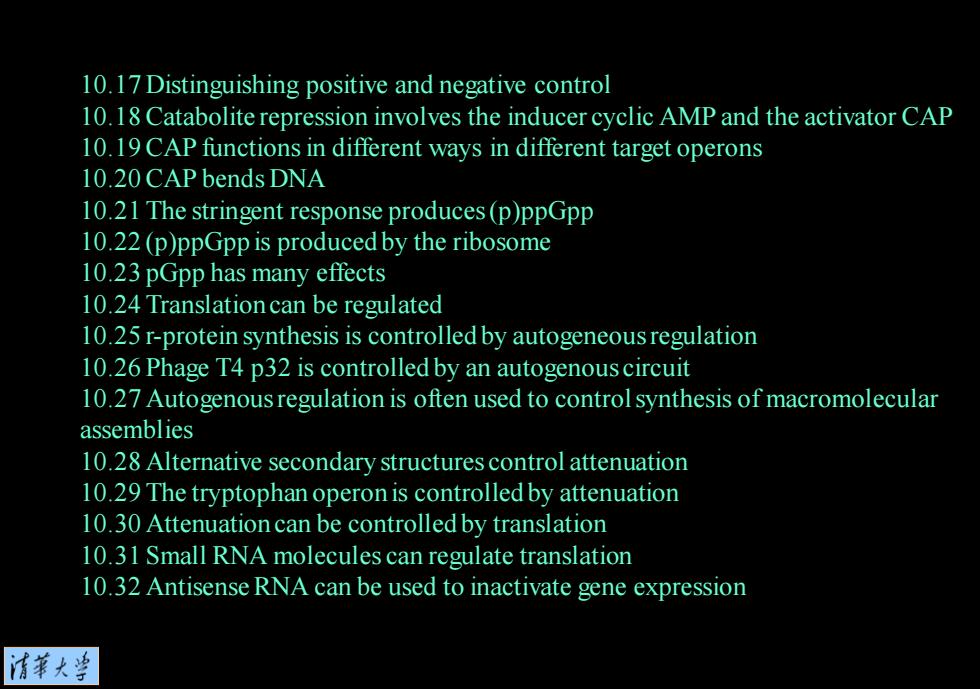
10.17 Distinguishing positive and negative control 10.18 Catabolite repression involves the inducer cyclic AMP and the activator CAP 10.19 CAP functions in different ways in different target operons 10.20 CAP bends DNA 10.21 The stringent response produces(p)ppGpp 10.22(p)ppGpp is produced by the ribosome 10.23 pGpp has many effects 10.24 Translation can be regulated 10.25 r-protein synthesis is controlled by autogeneous regulation 10.26 Phage T4 p32 is controlled by an autogenous circuit 10.27 Autogenousregulation is often used to control synthesis of macromolecular assemblies 10.28 Alternative secondary structures control attenuation 10.29 The tryptophan operon is controlled by attenuation 10.30 Attenuation can be controlled by translation 10.31 Small RNA molecules can regulate translation 10.32 Antisense RNA can be used to inactivate gene expression 清苇大当
10.17 Distinguishing positive and negative control 10.18 Catabolite repression involves the inducer cyclic AMP and the activator CAP 10.19 CAP functions in different ways in different target operons 10.20 CAP bends DNA 10.21 The stringent response produces (p)ppGpp 10.22 (p)ppGpp is produced by the ribosome 10.23 pGpp has many effects 10.24 Translation can be regulated 10.25 r-protein synthesis is controlled by autogeneous regulation 10.26 Phage T4 p32 is controlled by an autogenous circuit 10.27 Autogenous regulation is often used to control synthesis of macromolecular assemblies 10.28 Alternative secondary structures control attenuation 10.29 The tryptophan operon is controlled by attenuation 10.30 Attenuation can be controlled by translation 10.31 Small RNA molecules can regulate translation 10.32 Antisense RNA can be used to inactivate gene expression
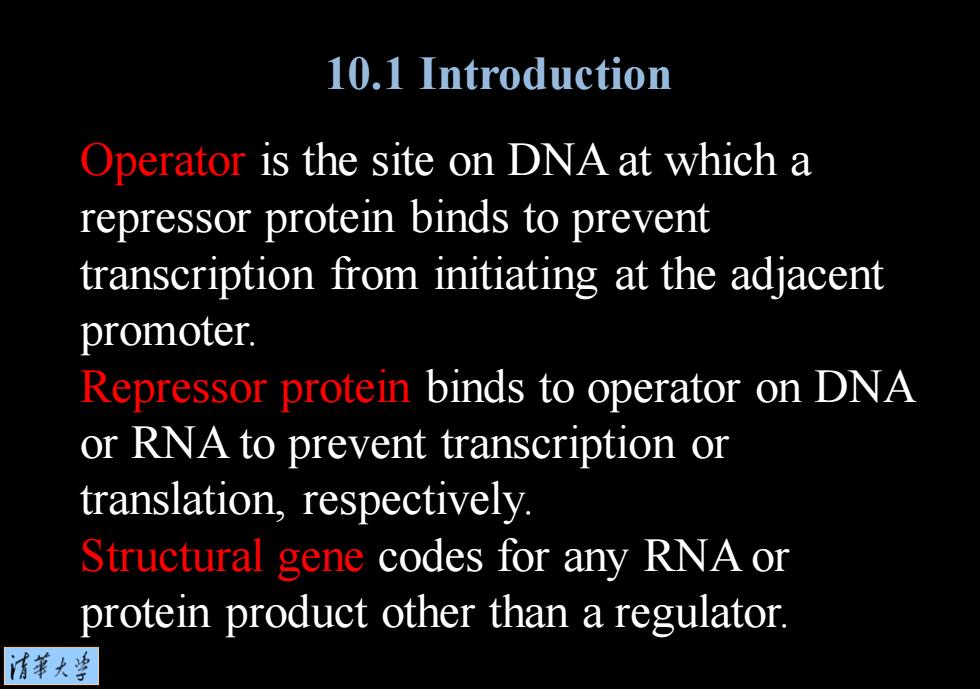
10.1 Introduction Operator is the site on DNA at which a repressor protein binds to prevent transcription from initiating at the adjacent promoter. Repressor protein binds to operator on DNA or RNA to prevent transcription or translation,respectively. Structural gene codes for any RNA or protein product other than a regulator. 情苇大兰
Operator is the site on DNA at which a repressor protein binds to prevent transcription from initiating at the adjacent promoter. Repressor protein binds to operator on DNA or RNA to prevent transcription or translation, respectively. Structural gene codes for any RNA or protein product other than a regulator. 10.1 Introduction
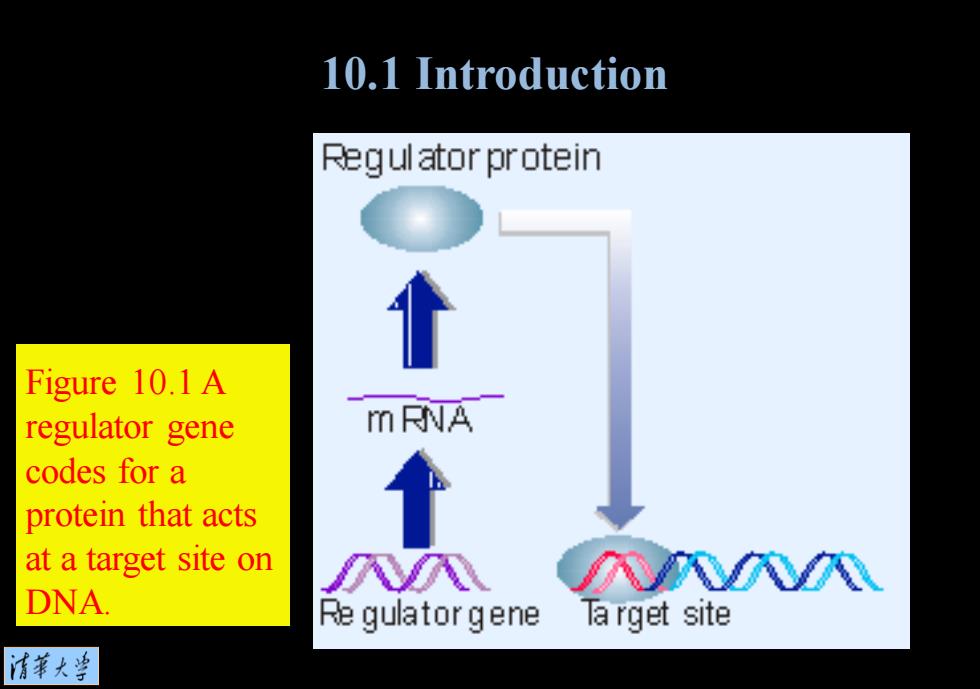
10.1 Introduction Reg ul ator protein Figure 10.1 A regulator gene mRNA codes for a protein that acts at a target site on DNA Re gulator gene la rget site 清第大当
Figure 10.1 A regulator gene codes for a protein that acts at a target site on DNA. 10.1 Introduction
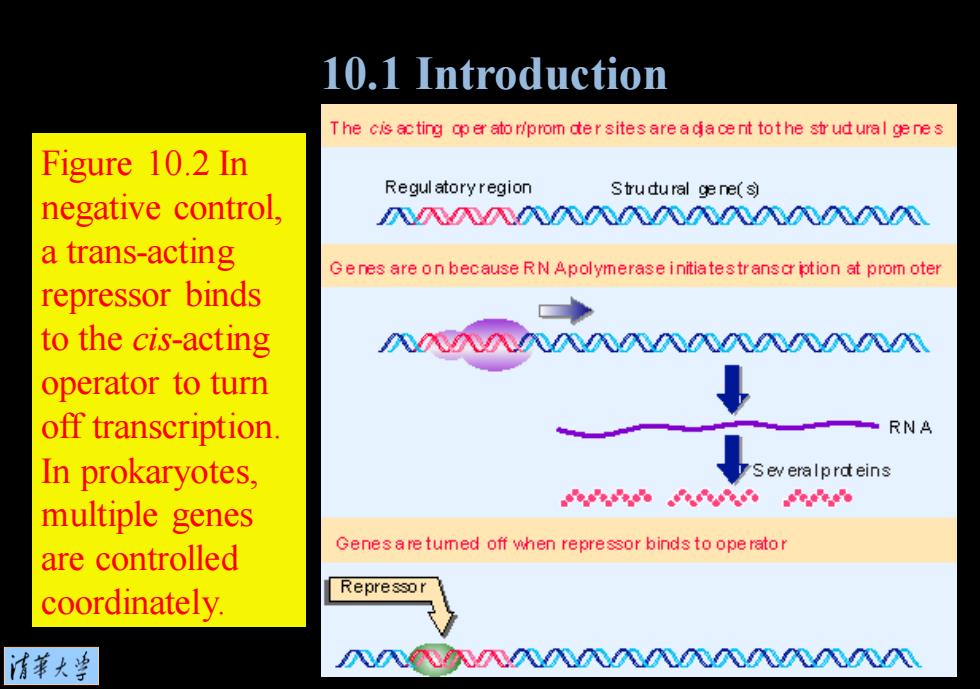
10.1 Introduction The cis acting cp er ato riprom dter sites are adacent tothe str ud ural genes Figure 10.2 In Regul atory region Strudural gene(s) negative control, N入入入八N八N八N八NNN八N a trans-acting Genes are on because RN Apolymerase initiatestranscr iption at prom oter repressor binds to the cis-acting NN入入NNN八LZ00020风N operator to turn off transcription RNA In prokaryotes, Sev eralprdeins multiple genes are controlled Genes are tumed off when repressor binds to ope rator Repressor coordinately. 清菜大当 八NN风N凡N八LZ02020020八
Figure 10.2 In negative control, a trans-acting repressor binds to the cis-acting operator to turn off transcription. In prokaryotes, multiple genes are controlled coordinately. 10.1 Introduction

10.1 Introduction Regulatory region prom oter Startpoint Structural genes Prom oter GENE OFF BY DEFAULT N八N八N八N八NNN八N风NN风NN RNA Factors interac with RNA polym erase GENE TURNED ON BY ACTIVATORS 八八入N八风入风风风风风风风风风风风风 RNA Single protein Figure 10.3 In positive control,trans-acting factors must bind to cis-acting sites in order for RNA polymerase to initiate transcription at the promoter. In a eukaryotic system,a structural gene is controlled individually 清萃大兰
Figure 10.3 In positive control, trans-acting factors must bind to cis-acting sites in order for RNA polymerase to initiate transcription at the promoter. In a eukaryotic system, a structural gene is controlled individually. 10.1 Introduction
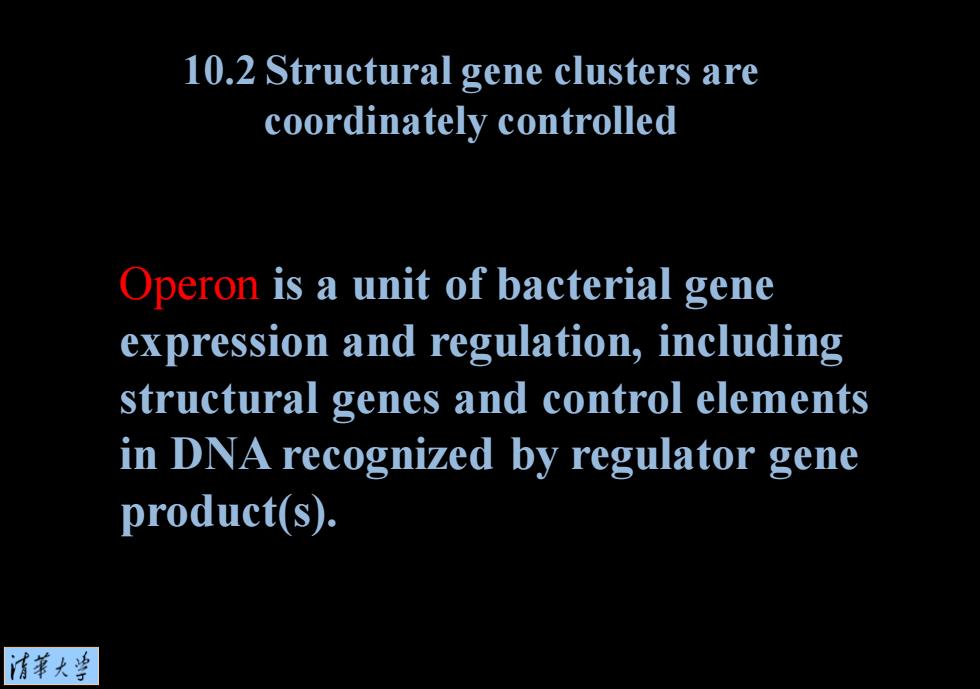
10.2 Structural gene clusters are coordinately controlled Operon is a unit of bacterial gene expression and regulation,including structural genes and control elements in DNA recognized by regulator gene product(s). 情華大当
Operon is a unit of bacterial gene expression and regulation, including structural genes and control elements in DNA recognized by regulator gene product(s). 10.2 Structural gene clusters are coordinately controlled
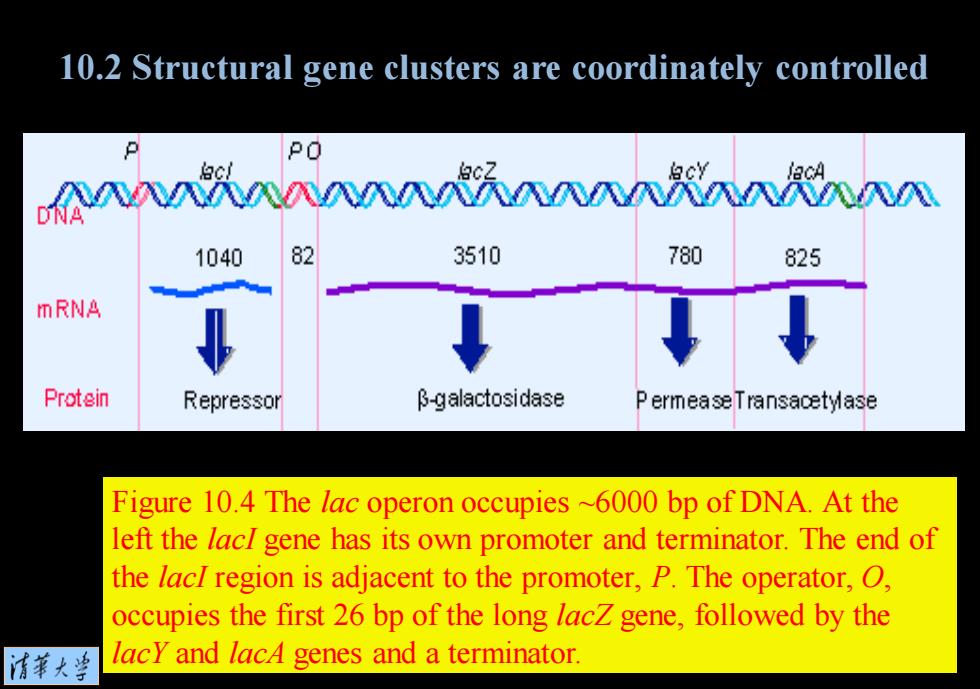
10.2 Structural gene clusters are coordinately controlled 公X入NN苏NNN P 1040 82 3510 780 825 mRNA Protein Repressor B-galactosidase P ermeaseTransacetyase Figure 10.4 The lac operon occupies ~6000 bp of DNA.At the left the lacl gene has its own promoter and terminator.The end of the lacl region is adjacent to the promoter,P.The operator,O, occupies the first 26 bp of the long lacZ gene,followed by the 清菜大当 lacY and lac4 genes and a terminator
Figure 10.4 The lac operon occupies ~6000 bp of DNA. At the left the lacI gene has its own promoter and terminator. The end of the lacI region is adjacent to the promoter, P. The operator, O, occupies the first 26 bp of the long lacZ gene, followed by the lacY and lacA genes and a terminator. 10.2 Structural gene clusters are coordinately controlled
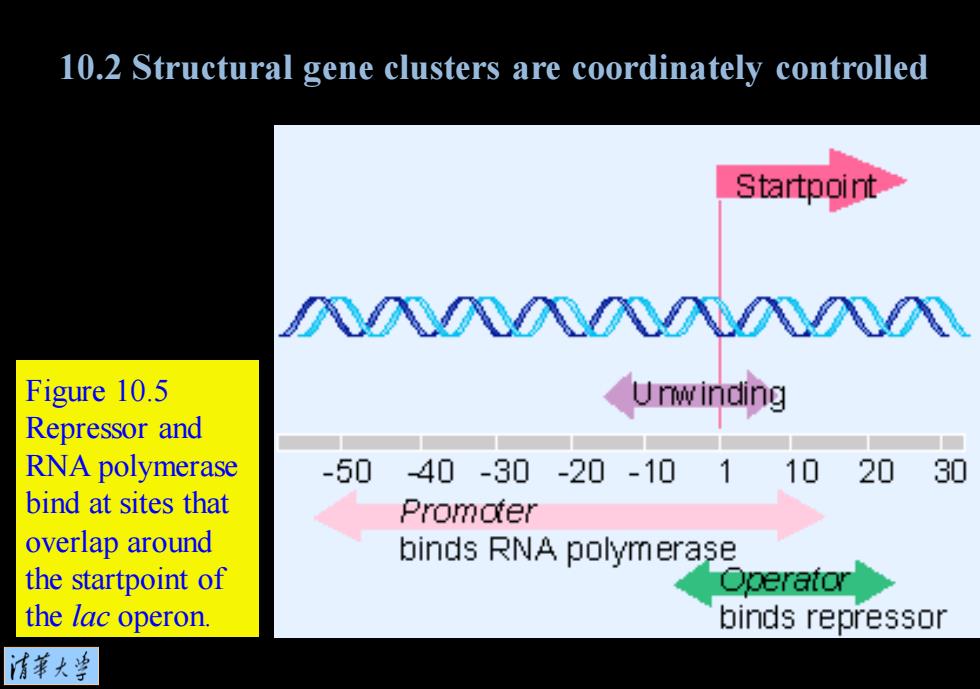
10.2 Structural gene clusters are coordinately controlled Startpoint Figure 10.5 Repressor and RNA polymerase -50-40-30-20-1011020 30 bind at sites that Promater overlap around binds RNA polymerase the startpoint of Operator the lac operon. binds repressor 清菜大当
Figure 10.5 Repressor and RNA polymerase bind at sites that overlap around the startpoint of the lac operon. 10.2 Structural gene clusters are coordinately controlled